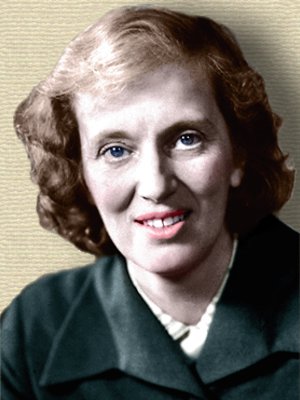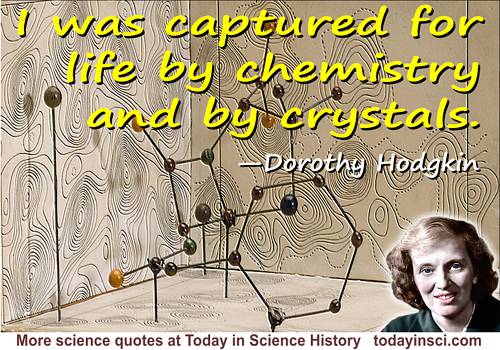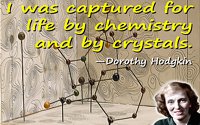 (source)
(source)
|
Dorothy Crowfoot Hodgkin
(12 May 1910 - 29 Jul 1994)
English biochemist and X-ray crystallographer (née Crowfoot) who was awarded the Nobel Prize for Chemistry in 1964 for her discoveries of the structure of biologically important molecules, including penicillin (1946), vitamin B-12 (1956), and the protein hormone insulin (1969).
|
Science Quotes by Dorothy Crowfoot Hodgkin (6 quotes)
… I became captivated by the edifices chemists had raised through experiment and imagination—but still I had a lurking question. Would it not be better if one could really “see” whether molecules as complicated as the sterols, or strychnine were just as experiment suggested?
— Dorothy Crowfoot Hodgkin
(11 Dec 1964) The X-ray analysis of complicated molecules, Nobel Lecture.
A great advantage of X-ray analysis as a method of chemical structure analysis is its power to show some totally unexpected and surprising structure with, at the same time, complete certainty.
— Dorothy Crowfoot Hodgkin
In 'X-ray Analysis of Complicated Molecules', Nobel Lecture (11 Dec 1964). In Nobel Lectures: Chemistry 1942-1962 (1964), 83.
From the intensity of the spots near the centre, we can infer that the protein molecules are relatively dense globular bodies, perhaps joined together by valency bridges, but in any event separated by relatively large spaces which contain water. From the intensity of the more distant spots, it can be inferred that the arrangement of atoms inside the protein molecule is also of a perfectly definite kind, although without the periodicities characterising the fibrous proteins. The observations are compatible with oblate spheroidal molecules of diameters about 25 A. and 35 A., arranged in hexagonal screw-axis. ... At this stage, such ideas are merely speculative, but now that a crystalline protein has been made to give X-ray photographs, it is clear that we have the means of checking them and, by examining the structure of all crystalline proteins, arriving at a far more detailed conclusion about protein structure than previous physical or chemical methods have been able to give.
— Dorothy Crowfoot Hodgkin
'X-Ray Photographs of Crystalline Pepsin', Nature (1934), 133, 795.
I should not like to leave an impression that all structural problems can be settled by X-ray analysis or that all crystal structures are easy to solve. I seem to have spent much more of my life not solving structures than solving them.
— Dorothy Crowfoot Hodgkin
In 'X-ray Analysis of Complicated Molecules', Nobel Lecture (11 Dec 1964). In Nobel Lectures: Chemistry 1942-1962 (1964), 88.
I used to say the evening that I developed the first x-ray photograph I took of insulin in 1935 was the most exciting moment of my life. But the Saturday afternoon in late July 1969, when we realized that the insulin electron density map was interpretable, runs that moment very close.
— Dorothy Crowfoot Hodgkin
'X-rays and the Structure of Insulin', British Medical Journal (1971), 4, 449.
I was captured for life by chemistry and by crystals.
— Dorothy Crowfoot Hodgkin
Oxford Dictionary of Quotations, 6th ed.
Quotes by others about Dorothy Crowfoot Hodgkin (1)
I think she [Rosalind Franklin] was a good experimentalist but certainly not of the first rank. She was simply not in the same class as Eigen or Bragg or Pauling, nor was she as good as Dorothy Hodgkin. She did not even select DNA to study. It was given to her. Her theoretical crystallography was very average.
Letter to Charlotte Friend (18 Sep 1979). In Francis Harry Compton Crick Papers, Wellcome Library for the History and Understanding of Medicine.
See also:
- 12 May - short biography, births, deaths and events on date of Hodgkin's birth.
- Dorothy Crowfoot Hodgkin - context of quote Captured for life by chemistry - Medium image (500 x 350 px)
- Dorothy Crowfoot Hodgkin - context of quote Captured for life by chemistry - Large image (800 x 600 px)
- Dorothy Hodgkin: A Life, by Georgina Ferry. - book suggestion.



 In science it often happens that scientists say, 'You know that's a really good argument; my position is mistaken,' and then they would actually change their minds and you never hear that old view from them again. They really do it. It doesn't happen as often as it should, because scientists are human and change is sometimes painful. But it happens every day. I cannot recall the last time something like that happened in politics or religion.
(1987) --
In science it often happens that scientists say, 'You know that's a really good argument; my position is mistaken,' and then they would actually change their minds and you never hear that old view from them again. They really do it. It doesn't happen as often as it should, because scientists are human and change is sometimes painful. But it happens every day. I cannot recall the last time something like that happened in politics or religion.
(1987) -- 


